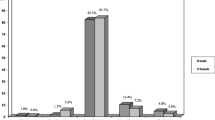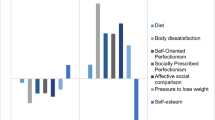Abstract
Aim
To examine factors (individual, familiar and socio-cultural) associated with body dissatisfaction (BD) by gender in non-clinical adolescents at risk of eating disorders (rED) and in a control group (CG).
Subjects and methods
A total of 2,967 adolescent students was screened using the Eating Attitudes Test-40 and the Youth’s Inventory-4. Of these, 217 students (161 girls and 56 boys) identified as being at rED were chosen for the study, and 208 students (168 girls and 40 boys) were chosen as the CG. The subjects were given the Body Areas Satisfaction Test, the Youth’s Inventory-4, a questionnaire to evaluate social influences on the “model of thinness” (SI-MT), the Family Environment Scale, and their body mass index (BMI) was determined.
Results
BD frequency in at-risk girls (44.6%) was significantly higher than in boys (27.3%). Girls at rED were most dissatisfied with their weight. BMIs were significantly higher and energy intake was significantly lower in dissatisfied girls than in satisfied girls at rED. In girls at rED, multiple linear regression analyses showed that SI-MT factors and dysthymia were associated with BD. In the CG, higher BMI were associated with BD. These relationships were not found in adolescent boys.
Conclusion
Within the at-risk group, adolescents with BD had higher BMIs, consumed fewer calories, were more influenced by socio-cultural factors and had more emotional issues than those who were satisfied. We suggest that although high BMIs are associated with BD, the interaction with other social and psychopathological characteristics increases the risk of the development of eating disorders.

Similar content being viewed by others
References
Baranowski M, Jorga J, Djordjevic I (2003) Evaluation of adolescent body satisfaction and associated eating disorder pathology in two communities. Eur Eat Disorders Rev 11:478–495
Beaton G, Milner J, Corey P, McGuire V, Cousins M, Stewart E, de Ramos N, Hewitt D, Grambsch P, Kassim N, Little J (1979) Sources of variance in 24-hour dietary recall data: implications for nutrition study design and interpretation. Am J Clin Nutr 12:2546–2559
Byely L, Archibald AB, Graber J, Brooks-Gunn J (2000) A prospective study of familial and social influences on girls’ body image and dieting. Int J Eat Disord 28:155–164
Canals J, Carbajo G, Fernandez-Ballart J (2002) Discriminant validity of the Eating Attitudes Test according to American Psychiatric Association and World Health Organization criteria of eating disorders. Psychol Rep 91:1052–1056
Canpolat BI, Orsel S, Akdemir A, Ozbay MH (2005) The relationship between dieting and body image, body ideal, self-perception, and body mass index in Turkish adolescents. Int J Eat Disord 37:150–155
Cash TF (1997) The body image workbook: an eight-step program for learning to like your looks. New Harbingen Publications, Oakland, CA
Castro J, Toro J, Salamero M, Guimerà E (1991) The Eating Attitudes Test: validation of the Spanish version. Psychol Assess 7:175–190
Cole T, Bellizzi M, Flegal K, Dietz W (2000) Establishing a standard definition for child overweight and obesity worldwide: international survey. BMJ 320:1–6
Cuadrado C, Carbajal A, Moreiras O (2000) Body perceptions and slimming attitudes reported by Spanish adolescents. Eur J Clin Nutr 54(Suppl 1):S65–S68
Davison KK, Markey CN, Birch LL (2003) A longitudinal examination of patterns in girls’ weight concerns and body dissatisfaction from ages 5 to 9 years. Int J Eat Disord 33:320–332
Derenne JL, Beresin EV (2006) Body image, media, and eating disorders. Acad Psychiatry 30:257–261
Favier J, Ireland-Ripert J, Toque C, Feinberg M (1997) Répertoire general des aliments. Table de composition. TEC & doc Lavoiseir-INRA, Paris
Gadow K, Sprafkin J (1997) In: Youth’s inventory-4 Manual. Quick guide to using the Youth’s Inventory-4 Screening Kit. Checkmate plus, Ltd., Stony Brook, NY
Garner DM, Garfinkel PE (1979) The Eating Attitudes Test: an index of the symptoms of anorexia nervosa. Psychol Med 9:273–279
Hawkins N, Richards P, Granley H, Stein D (2004) The impact of exposure to the thin-ideal media image on women. Eat Disord Pring 12:35–50
Hodges EL, Cochrane CE, Brewerton TD (1998) Family characteristics of binge-eating disorder patients. Int J Eat Disord 23:145–151
Lee AM, Lee S (1996) Disordered eating and its psychosocial correlates among Chinese adolescent females in Hong Kong. Int J Eat Disord 20:177–183
McCabe MP, Ricciardelli LA (2005) A prospective study of pressures from parents, peers, and the media on extreme weight change behaviors among adolescent boys and girls. Behav Res Ther 43:653–668
Morrison TG, Kalin R, Morrison MA (2004) Body-image evaluation and body-image investment among adolescents: a test of sociocultural and social comparison theories. Adolescence 39:571–592
Moos RH, Moos B (1986) Family enviroment scalae manual, 2nd edn. Consulting Psychologist Press, Inc Palo Alto, CA
Ohzeki T, Otahara H, Hanaki K, Motozumi H, Shiraki K (1993) Eating attitudes test in boys and girls aged 6–18 years: decrease in concerns with eating in boys and the increase in girls with their ages. Psychopathology 26:117–121
Presnell K, Bearman SK, Stice E (2004) Risk factors for body dissatisfaction in adolescent boys and girls: a prospective study. Int J Eat Disord 36:389–401
Rukavina T, Pokrajac-Bulian A (2006) Thin-ideal internalization, body dissatisfaction and symptoms of eating disorders in Croatian adolescent girls. Eat Weight Disord 11:31–37
Sands ER, Wardle J (2003) Internalization of ideal body shapes in 9–12-year-old girls. Int J Eat Disord 33:193–204
Stice E, Bearman SK (2001) Body-image and eating disturbances prospectively predict increases in depressive symptoms in adolescent girls: a growth curve analysis. Dev Psychol 37:597–607
Stice E, Shaw HE (2002) Role of body dissatisfaction in the onset and maintenance of eating pathology: a synthesis of research findings. J Psychosom Res 53:985–993
Thompson JK, Smolak L (2001) Body image, eating disorders and obesity in youth. American Psychological Association, Washington, DC
Tiggemann M, Wilson-Barrett E (1998) Children’s figure ratings: relationship to self-esteem and negative stereotyping. Int J Eat Disord 23:83–88
Toro J, Gila A, Castro J, Pombo C, Guete O (2005) Body image, risk factors for eating disorders and sociocultural influences in Spanish adolescents. Eat Weight Disord 10:91–97
Unikel C, Aguilar J, Gomez-Peresmitre G (2005) Predictors of eating behaviors in a sample of Mexican women. Eat Weight Disord 10:33–39
Acknowledgments
This project was supported by Health Research Funds from the Spanish Ministry of Health and Consumer Affairs (ref. 01/1364). We would like to thank to Mr John Bates, the head of English language department of the Rovira I Virgili University, for the translation of the manuscript.
Conflict of interest statement
We state that we do not have any conflict of interest.
Author information
Authors and Affiliations
Corresponding author
Rights and permissions
About this article
Cite this article
Babio, N., Arija, V., Sancho, C. et al. Factors associated with body dissatisfaction in non-clinical adolescents at risk of eating disorders. J Public Health 16, 107–115 (2008). https://doi.org/10.1007/s10389-007-0133-1
Received:
Accepted:
Published:
Issue Date:
DOI: https://doi.org/10.1007/s10389-007-0133-1




